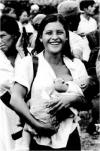Abstract
The theme of self-transformation as part of a renewal of society was the essence of all 20th century revolutions, embodied inthe figure on the ‘New Man’ that will bring about the new revolutionary society of the future. This concept was a crucial part ofthe ideology of the fsln. This paper will concentrate on how the New Woman emerged in revolutionary Nicaragua visual arts,specifically in murals executed across the country contributing to create the new revolutionary landscape. One image in particular,a photograph taken by Nicaraguan photographer Orlando Valenzuela of a Sandinista female combatant titled “Milicianade Waswalito” or “Armed mother and Child” became worldwide known. This image became an international icon of the NewWoman of the revolution and will appear as a recurrent motive and almost exclusively in the murals commissioned by amnlae(Asociación de Mujeres Nicaragüenses “Luisa Amanda Espinoza”) when in the most important murals commissioned by thegovernment the depiction of the New Woman embodied the archetypes of motherhood and femininityApuntes is registered under a Creative Commons Attribution 4.0 International Public License. Thus, this work may be reproduced, distributed, and publicly shared in digital format, as long as the names of the authors and Pontificia Universidad Javeriana are acknowledged. Others are allowed to quote, adapt, transform, auto-archive, republish, and create based on this material, for any purpose (even commercial ones), provided the authorship is duly acknowledged, a link to the original work is provided, and it is specified if changes have been made. Pontificia Universidad Javeriana does not hold the rights of published works and the authors are solely responsible for the contents of their works; they keep the moral, intellectual, privacy, and publicity rights.
Approving the intervention of the work (review, copy-editing, translation, layout) and the following outreach, are granted through an use license and not through an assignment of rights. This means the journal and Pontificia Universidad Javeriana cannot be held responsible for any ethical malpractice by the authors. As a consequence of the protection granted by the use license, the journal is not required to publish recantations or modify information already published, unless the errata stems from the editorial management process. Publishing contents in this journal does not generate royalties for contributors.


